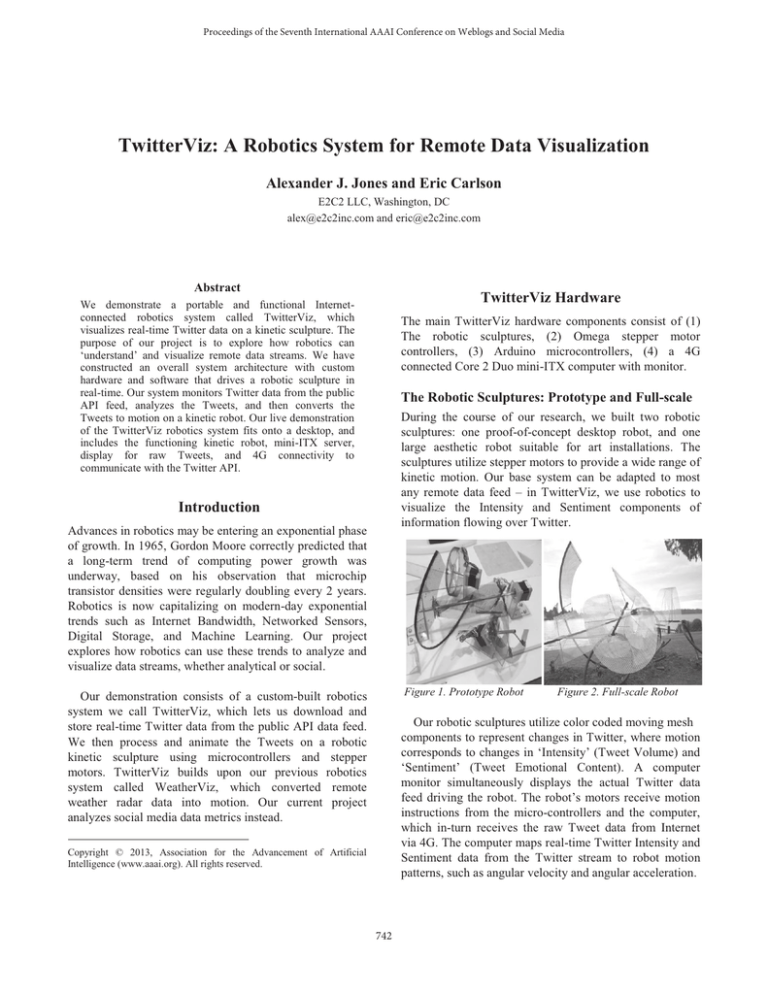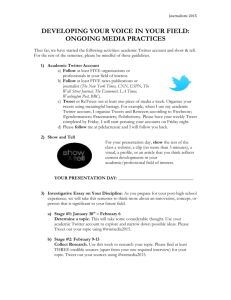
Proceedings of the Seventh International AAAI Conference on Weblogs and Social Media
TwitterViz: A Robotics System for Remote Data Visualization
Alexander J. Jones and Eric Carlson
E2C2 LLC, Washington, DC
alex@e2c2inc.com and eric@e2c2inc.com
Abstract
TwitterViz Hardware
We demonstrate a portable and functional Internetconnected robotics system called TwitterViz, which
visualizes real-time Twitter data on a kinetic sculpture. The
purpose of our project is to explore how robotics can
‘understand’ and visualize remote data streams. We have
constructed an overall system architecture with custom
hardware and software that drives a robotic sculpture in
real-time. Our system monitors Twitter data from the public
API feed, analyzes the Tweets, and then converts the
Tweets to motion on a kinetic robot. Our live demonstration
of the TwitterViz robotics system fits onto a desktop, and
includes the functioning kinetic robot, mini-ITX server,
display for raw Tweets, and 4G connectivity to
communicate with the Twitter API.
The main TwitterViz hardware components consist of (1)
The robotic sculptures, (2) Omega stepper motor
controllers, (3) Arduino microcontrollers, (4) a 4G
connected Core 2 Duo mini-ITX computer with monitor.
The Robotic Sculptures: Prototype and Full-scale
During the course of our research, we built two robotic
sculptures: one proof-of-concept desktop robot, and one
large aesthetic robot suitable for art installations. The
sculptures utilize stepper motors to provide a wide range of
kinetic motion. Our base system can be adapted to most
any remote data feed – in TwitterViz, we use robotics to
visualize the Intensity and Sentiment components of
information flowing over Twitter.
Introduction
Advances in robotics may be entering an exponential phase
of growth. In 1965, Gordon Moore correctly predicted that
a long-term trend of computing power growth was
underway, based on his observation that microchip
transistor densities were regularly doubling every 2 years.
Robotics is now capitalizing on modern-day exponential
trends such as Internet Bandwidth, Networked Sensors,
Digital Storage, and Machine Learning. Our project
explores how robotics can use these trends to analyze and
visualize data streams, whether analytical or social.
Figure 1. Prototype Robot
Our demonstration consists of a custom-built robotics
system we call TwitterViz, which lets us download and
store real-time Twitter data from the public API data feed.
We then process and animate the Tweets on a robotic
kinetic sculpture using microcontrollers and stepper
motors. TwitterViz builds upon our previous robotics
system called WeatherViz, which converted remote
weather radar data into motion. Our current project
analyzes social media data metrics instead.
Figure 2. Full-scale Robot
Our robotic sculptures utilize color coded moving mesh
components to represent changes in Twitter, where motion
corresponds to changes in ‘Intensity’ (Tweet Volume) and
‘Sentiment’ (Tweet Emotional Content). A computer
monitor simultaneously displays the actual Twitter data
feed driving the robot. The robot’s motors receive motion
instructions from the micro-controllers and the computer,
which in-turn receives the raw Tweet data from Internet
via 4G. The computer maps real-time Twitter Intensity and
Sentiment data from the Twitter stream to robot motion
patterns, such as angular velocity and angular acceleration.
Copyright © 2013, Association for the Advancement of Artificial
Intelligence (www.aaai.org). All rights reserved.
742
our previous robotics visualization projects. The database
of Tweets is stored on a large terabyte archive partition
utilizing key indexing. We make continuous updates to the
SQL database as the Tweets flow in from the network. We
also store associated metadata, which are included in the
JSON objects provided by Twitter. Tweets include source
username, time stamp, Twitter message content, user
information, and optional geolocation data.
Arduino Microcontrollers and Stepper Motors
The Omega Stepper Motors in our robotic sculpture create
the kinetic motion to represent Twitter metric changes over
time. We drive our Omega stepper motors using an
Omega 3540M driver unit. We utilize micro stepping in
our application because it gives the aesthetically smoothest
operation (2000 steps/rev). The Omega driver is controlled
from an Arduino Microcontroller, which runs custom code
written in Processing (Banzi, 2010), which sends RPM
updates to the motor driver as they are received from the
computer. The computer speaks to the Arduino via USB
ports running the Firmata Protocol (Steiner, 2010).
TwitterVizWorkbench Software
We have adapted our WeatherViz software to conduct
analysis on Twitter feeds, in order to produce two
parameters with which to drive our robotic sculpture – 1)
That of ‘Intensity’, which represents the overall Twitter
data flow rate (Tweets/second) in real-time -- which is
converted to kinetic motion. The second parameters is that
of ‘Sentiment’, for which we use open-source sentiment
analysis tools to classify Tweets as to their linguistic
sentiment (positive emotion or negative emotion), which
then effects the motion of the sculpture (and underlying
stepper motors) accordingly.
Figure 3. Omega Stepper Motor and 3540M
TwitterViz Software
The TwitterViz Software was adapted from our previous
WeatherViz software, which was written in C#.
TwitterViz includes a Python script which connects to the
Twitter RESTful API using a developer key, and retrieves
streaming information from both the current ‘garden hose’
(a total ~1% statistical sampling of all Tweets), as well as a
sub-set of Tweets filtered by a user-specified keyword.
The software runs on a mini-ITX Core2 Duo computer,
and consists of 1) an Internet-connected Twitter data
scraper with statistical auto-analysis and SQL database, 2)
an integrated GUI tool that drives the robot sculpture by
letting the user select Tweet feed keywords, displaying raw
Tweets and classified sentiment; and synchronizing the
microcontroller interface to the current data stream, for
parameters of Tweet Intensity and Tweet Sentiment.
Figure 4. TwitterVizWorkbench Software
The software displays the statistical information
analyzed and derived from Twitter, as it drives the
TwitterViz robot’s Arduino microcontrollers and stepper
motors with the underling Tweet data – Twitter Intensity
and Tweet Sentiment. The robot’s kinetic motion patterns
are time-synchronized with the Twitter data displayed on
the screen. The software is fully configurable, to include
robot motions for particular Twitter data metrics.
References
TwitterVizNetwork Software
We have adapted our WeatherViz Network software for
Twitter to download and store the Twitter JSON object
data from the RESTful data feed in a mySQL database.
The object metadata is timestamped and stored for analysis
using our existing graphing and analytical tools written for
Fry, B. 2010. Processing [computer software].
http://processing.org
Steiner, H. 2010. Firmata [computer software].
http://firmata.org
743




